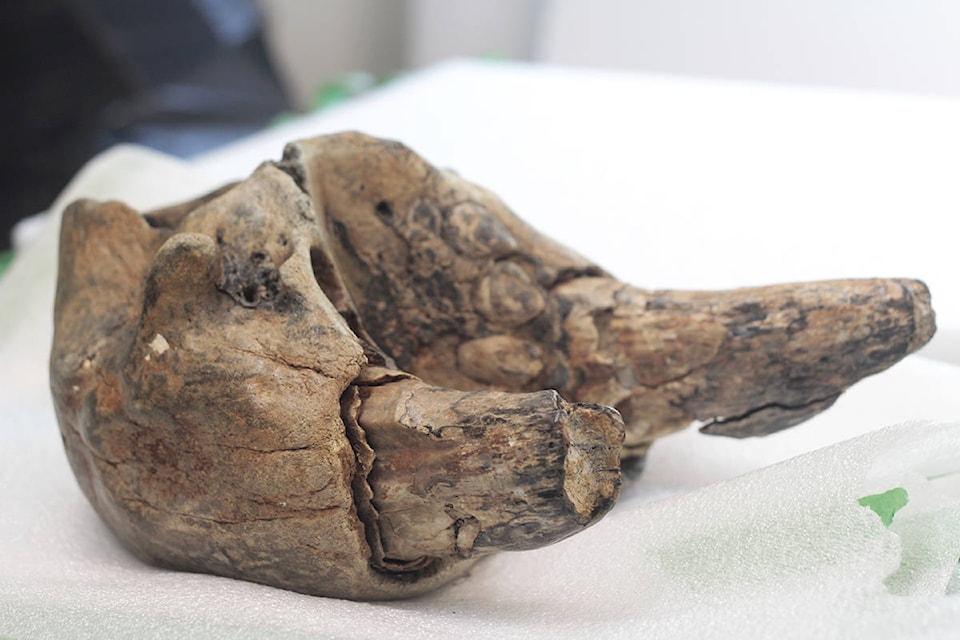It’s really, really old news.
One stormy day in February, Nicole Day and a couple friends were collecting agates on a beach west of Tow Hill when she saw something — bones in the sand.
“I thought it was a sea lion tooth or something,” said Day, who had beachcombed a glass ball and several fossils before, but never preserved bone.
Helped by a southeast wind blowing 50 kilometres an hour, Day swept the sand away.
What she uncovered weren’t teeth exactly, but tusks.
Walrus tusks.
They were broken off well before the tips, but still attached to a skull alongside a half-dozen regular teeth.
The whole thing was fossilized, heavy as stone.
Walruses like to eat clams more than anything, so food-wise, Haida Gwaii’s north coast could be a walrus hotspot.
But another thing walruses enjoy is sea ice, and lots of it — they thrive at the edge of Arctic ice sheets, so long as the ice is thick enough to support their blubbery bodies, which weigh up to 4,000 pounds.
In fact, besides showing off, walruses use their long ivory tusks to grapple the ice and haul themselves out from the water to rest.
The last time Haida Gwaii had that sort of sea ice around, an ice age was in retreat — the most recent lasted from about 37,000 to 15,000 years ago.
So the big question, when Nicole Day bundled up the first known walrus skull found on Haida Gwaii and then showed it to local researchers, was just how old is it?
“Forty-two thousand years old,” says Sean Young, the collections curator at the Haida Gwaii Museum, who grew up dirt-biking the beaches where it was found.
“It fits into what they call the interglacial period,” he added, meaning a time between the most recent ice age and an even older one.
Guided by people like Daryl Fedje, an archaeologist who has used paleoecology to trace the early prehistory on Haida Gwaii, Young took on a daunting job to learn that information — he had to chisel off a skull fragment for radiocarbon dating.
“It wasn’t the most fun thing to do,” he said, laughing.
Luckily, Young found a sliver at the base of the skull that was already fractured, and only needed a gentle tap.
It turned out to be a good sample — the date came back with an error margin of just 1,300 years, quite small for something so old.
Day’s find may only be one of only three Pleistocene walrus fossils found on the West Coast.
One was dredged from San Francisco Bay, and dated to about 28,000 years old.
The best preserved is ‘Rosie,’ a 60,000-year-old walrus fossil of the species Odobenus Rosmarus, which was found by a man gathering shellfish near Qualicum Beach in 1979.
Like Day, he saw the tusks poking out first, but when his daughter’s biology teacher excavated the rest, they uncovered most of the skeleton except for the vertebrae, ribs, and pelvis.
Young, Fedje and others hope to find and excavate the rest of the skeleton that Day found.
Following a recent study of 130,000-year-old mastodon bones found in San Diego with what appear to be human tool marks, they will certainly keep a sharp eye out for any evidence of human activity.
But Young has a couple other things to do first.
One is to make a custom display for the skull in the natural history wing of the Haida Gwaii Museum, which is due to re-open this summer. It may include links to SGuuluu Jaad, or Sea Foam Woman, the Haida supernatural whose story refers to forming ice sheets.
With precise, real-time controls for temperature, humidity, and airflow, Young said the islands museum is as ready for that task as the Royal Tyrrell Museum of Palaeontology in Alberta, or the Smithsonian in the U.S.
Young would also like to make castings of the skull — another delicate job that involves some surprisingly simple tools, including a sandbox, cellophane, dental cement, and a load of sand-blasting sand from NAPA Auto Parts.
Some castings will go to local schools to liven up science class, said Young, but another will go to Nicole Day as a thank-you for donating her find, and taking care of it until the museum was ready.
“It’s such an important find,” he said. “I found it important that they get something for donating it to the museum.”
Day said she’s enjoyed seeing so many people excited by the find, not to mention learning a whole lot about walruses.
“I didn’t know anything about walruses particularly,” she said, laughing. “I’m just a beachcomber”
“I want people to see it, because I think it’s a really beautiful artifact.”
